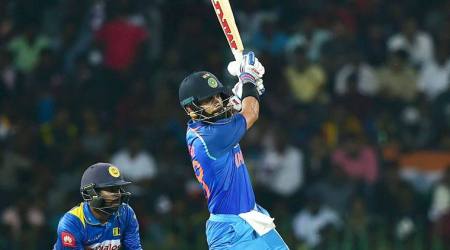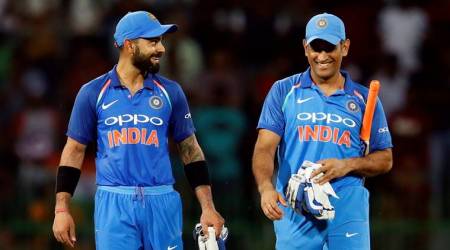 Indian cricket team enjoyed a ride after they concluded the ODI series winning the fifth match. (Source: AP)
Indian cricket team enjoyed a ride after they concluded the ODI series winning the fifth match. (Source: AP)
Lasith Malinga bowled a bouncer to Ajinkya Rahane and made the ball climb sharply. The opener, Shikhar Dhawan’s replacement in the fifth and final ODI on Sunday, was in no position to hook. But the previous 16 balls that Rahane had faced yielded only five runs. So he made a desperate attempt to up the ante, top-edging the delivery to Dilshan Munaweera at deep backward square leg in the process.
Four overs later, Malinga bowled a similar delivery to Virat Kohli, although it was a slower bouncer. The India captain got on top of it, rolled his wrists and placed the ball past square leg for a single.
More than the difference in class between the two batsmen, a stark contrast in terms of mental comfort zone became apparent. Something within Rahane snaps when he plays limited-overs cricket for India, especially on slower pitches like the one at Premadasa for Sunday’s match. On the other hand, during the course of his 30th ODI hundred — he equalled Ricky Ponting, playing 179 innings less — Kohli once again showed his team mate the benefits of staying relaxed.
 While Virat Kohli recorded his 30th ODI century, MS Dhoni became the wicketkeeper to effect 100 ODI stumpings. (Source: AP)
While Virat Kohli recorded his 30th ODI century, MS Dhoni became the wicketkeeper to effect 100 ODI stumpings. (Source: AP)
In the press box, American travel writer David Code was startled by Kohli’s relaxed body language and power of concentration. He was even more surprised to know that the knuckleball has been baseball’s export to cricket. After watching Bhuvneshwar Kumar, the writer concluded that it was immensely more difficult to bowl the variety over-arm.
Kumar started practising the knuckle ball after the home Test series against Australia earlier this year. He learnt the tricks of the trade quickly and used it in the IPL, mainly towards the back end of the innings. On Sunday, he used it up front, after Sri Lanka won the toss and chose to bat, to dismiss Niroshan Dickwella and Munaweera. The former tried to play a flick, but completely deceived by the ball’s mid-air dip, Dickwella tamely spooned it back to the bowler. Kumar’s first wicket of the series was followed by Munaweera’s scalp, as the batsman made room to clear mid-off but mistimed. Kohli took a sensational catch diving backwards.
After a three-match wicket drought in this series (plus two in the West Indies), Kumar was rested in the previous game. Returning to the side in place of Hardik Pandya, as India made four changes for the final ODI, the medium pacer returned with his maiden ODI five-for — 5/42 in 9.4 overs. His previous best 4/8, too, was against Sri Lanka at Port of Spain in 2013. While the hosts’ top order was rattled with the knuckleballs. Kumar’s next three wickets came towards the latter half of the innings, bowling conventional stuff. A well-set Lahiru Thirimanne, and Siriwardana and Malinga were the victims.
 Bhuvneshwar Kumar claimed his first five-wicket haul in ODI cricket. (Source: AP)
Bhuvneshwar Kumar claimed his first five-wicket haul in ODI cricket. (Source: AP)
Wrist work
Kumar’s wickets notwithstanding, Sri Lanka initially had been going at over run-a-ball because Shardul Thakur was leaking runs at the other end. Jasprit Bumrah removed an aggressive Upul Tharanga with a beauty to stem the run flow and Kohli brought on spin early, in the 11th over, introducing Kuldeep Yadav. Yuzvendra Chahal’s return in this game saw two wrist spinners bowl in tandem. Together they conceded only 76 runs in 20 overs, accounting for Angelo Mathews and Akila Dananjaya respectively.
The two wrist spinners gave away only four boundaries between them, a reason why Sri Lanka choked to 238 all out in 49.4 overs despite having a 122-run fourth-wicket partnership between Thirimanne and Mathews. Both perished after scoring half-centuries and the hosts unerringly maintained their habit of a lower-order slide.
Coming back to Kohli whose 116-ball 110 not out made India’s six-wicket win and a 5-0 clean sweep a cakewalk. It was a different knock compared to his belligerence here three days ago. Rahane never looked settled. And after back-to-back hundreds, Rohit got out to an attempted ramp shot here. So the skipper had to do some resurrection job. His first shot of real aggression came after 12 balls; a delightful back foot drive off Vishwa Fernando through extra cover for four. One ball later, he contemptuously dispatched the left-arm quick to the straight boundary.
 Manish Pandey and Virat Kohli forged a 99-run partnership as India won the series 5-0.
Manish Pandey and Virat Kohli forged a 99-run partnership as India won the series 5-0.
As Dananjaya came to bowl, Kohli decided to milk the spinner. His footwork and placements forced the young Sri Lankan to mainly stick to his off-spinners and not experiment much. Mathews bowled a tight line from the other end and the India captain gave him due respect, without allowing the pressure to build. Singles and twos kept the scoreboard moving.
Manish Pandey, batting at No. 4 with KL Rahul rested, gave his skipper good support during a 99-run third wicket partnership. But the Karnataka batsman wasted a chance to cement his place in the middle order, playing a poor shot and getting out for 36.
Kedar Jadhav came at No. 5 and played an important innings, adding 109 runs with Kohli for the fourth wicket. India were home and dry when Jadhav departed but Sri Lanka slipped deeper in the mire with yet another loss. For the first time, they conceded an ODI series 5-0 on home soil.

